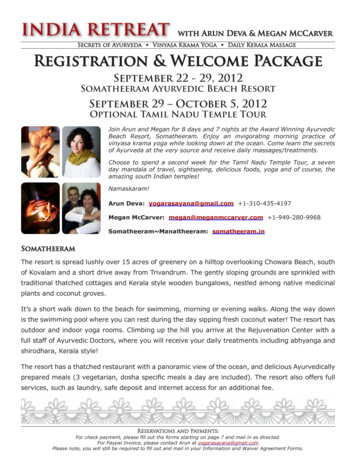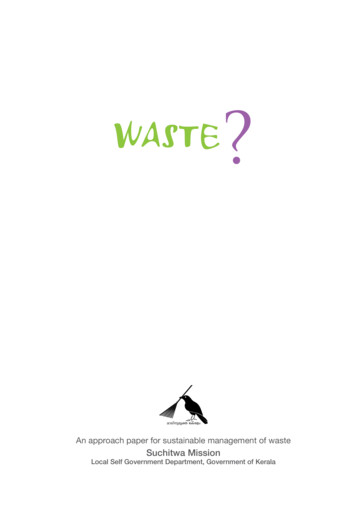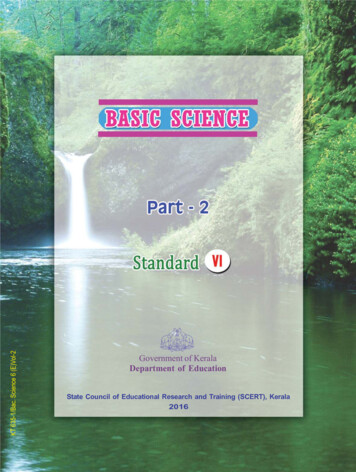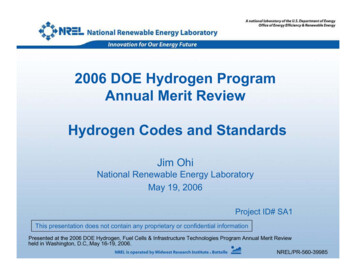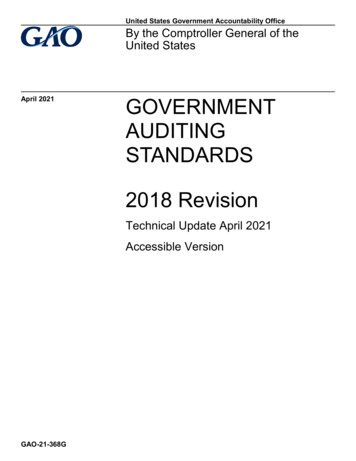
Transcription
Government of KeralaDEPARTMENT OF EDUCATIONState Council of Educational Research and Training (SCERT); Kerala2015
THE NATIONAL ANTHEMJana-gana-mana adhinayaka, jaya angaUchchala-Jaladhi-tarangaTava subha name jage,Tava subha asisa mage,Gahe tava jaya gatha.Jana-gana-mangala-dayaka jaya heBharatha-bhagya-vidhata.Jaya he, jaya he, jaya he,Jaya jaya jaya, jaya he!PLEDGEIndia is my country. All Indians are my brothers andsisters.I love my country, and I am proud of its rich and variedheritage. I shall always strive to be worthy of it.I shall give respect to my parents, teachers and allelders and treat everyone with courtesy.I pledge my devotion to my country and my people.In their well-being and prosperity alone lies myhappiness.Prepared by:State Council of Educational Research and Training (SCERT)Poojappura, Thiruvananthapuram 695012, KeralaWebsite : www.scertkerala.gov.in e-mail : scertkerala@gmail.comPhone : 0471 - 2341883, Fax : 0471 - 2341869Typesetting and Layout : SCERT Department of Education, Government of Kerala
Dear students,Computer Science, a subject belonging to the discipline of Scienceand of utmost contemporary relevance, needs continuousupdating. The Higher Secondary Computer Science syllabus hasbeen revised with a view to bringing out its real spirit anddimension. The constant and remarkable developments in the fieldof computing as well as the endless opportunities of research inthe field of Computer Science and Technology have been included.In Class XI, we started with the history of computing followed byhardware and software components, computer network andInternet. The major part of the textbook as well as the syllabusestablished a strong foundation to construct and enhance theproblem solving and programming skills of the learner.The syllabus of Class XII gives thrust on the means of handlingcomplex data involved in problem solving and the developmentof web applications. The textbook, designed in accordance withthe syllabus, begins with some advanced features of C programming language like structures and pointers. Webtechnology is introduced with the theoretical background andproceeds with the design of simple web pages followed by a briefidea about both client-side and server-side scripting. The conceptof database and facilities of information retrieval are included. Anexclusive section about the advances in computing opens the doorto the latest developments in the world of computing discipline.Considering the increase in the use of Internet, an awareness aboutCyber laws is also presented to safeguard against Cyber crimes.I hope this book will meet all the requirements for stepping to levelsof higher education in Computer Science and pave your way tothe peak of success.Wish you all success.Dr S. Raveendran NairDirectorSCERT, Kerala
1.Structures and Pointers1.11.21.31.4StructurePointerMethods of memory allocationOperations on ter and ArrayPointer and StringPointer and StructureConcepts of Object Oriented ProgrammingProgramming paradigm2.241Basic concepts of OOPData Structures and OperationsData structureStack3.33.459QueueLinked listWeb TechnologyCommunication on the webWeb server technologiesWeb designingStatic and dynamic web pagesScriptsCascading Style SheetBasic concepts of HTML documentsCreating an HTML document854.9 Essential HTML tags4.10 Some common tags4.11 HTML entities for reservedcharacters4.12 Adding comments in HTMLdocument4.13 Inserting imagesWeb Designing Using HTMLLists in HTMLCreating linksInserting music and videoCreating tables in a web page5.55.65.7135Dividing the browser windowForms in web pagesOverview of HTML 5Client Side Scripting Using JavaScriptGetting started with JavaScriptCreating functions in JavaScriptData types in JavaScriptVariables in JavaScriptOperators in JavaScript6.66.76.86.9Control structures in JavaScriptBuilt-in functionsAccessing values in a text box usingJavaScriptWays to add scripts to a web page7.37.4Content Management SystemResponsive web designWeb HostingWeb hostingFree hosting177221
Icons used in this textbookLet us doKnow your progressInformation boxLet us practiceLet us conclude
1Significant Learning OutcomesAfter the completion of this chapter, thelearner identifies the need of user-defineddata types and uses structures torepresent grouped data. creates structure data types andaccesses elements to refer to thedata items. uses nested structures to representdata consisting of elementary dataitems and grouped data items. develops C programs usingstructure data types for solving reallife problems. explains the concept of pointer anduses pointer with the operators &and *. compares the two types of memoryallocations and uses dynamicoperators new and delete. illustrates the operations onpointers and predicts the outputs. establishes the relationshipbetween pointer and array. uses pointers to handle strings. explains the concept of selfreferential structures.Structures and PointersWe started writing C programs inClass XI for solving problems.Almost all problems are related tothe processing of different types of data. Lastyear we came across only elementary data itemssuch as integers, fractional numbers, charactersand strings. We used variables to refer to thesedata and the variables are declared using basicdata types of C . We know that all data isnot of fundamental (basic) types; rather manyof them may be composed of elementary dataitems. No programming language can providedata types for all kinds of data. Soprogramming languages provide facility todefine new data types, as desired by the users.In this chapter, we will discuss such a userdefined data type named structure. Thischapter also discusses a new kind of variableknown as pointer. The concept of pointers is atypical feature of languages like C, C . Ithelps to access memory locations by specifyingthe memory addresses directly, which makesexecution faster. A good understanding of thisconcept will help us to design data structureapplications and system level programs.Last year you might have used GNU CompilerCollection (GCC) with Geany IDE or TurboC IDE for developing C programs.
Computer Science - XIIGCC differs from Turbo C IDE in the structure of source code, the way ofincluding header files, the size of int and short, etc. In this chapter the concepts arepresented based on GCC.1.1 StructuresNow-a-days students, employees, professionals, etc. wear identity cards issued byinstitutions or organisations. Figure 1.1 shows the identity card of a student. Thefirst column of Table 1.1 contains some of the data printed on the card. You try tofill up the second column with the appropriate C data types discussed in Class XI.DataFig.1.1: ID card of a studentC data type12345Sneha S. Raj20/02/1997O veSnehanilayam,Gandhi Nagar,Chemmanavattom,Pin 685 531Table 1.1: Data and C data typesYou may use short or int for admission number (12345), char array for name(Sneha S. Raj), blood group (O ve) and even address. Sometimes you may not beable to identify the most appropriate data types for date of birth and address. Letus consider the data 20/02/1997 and analyse the composition of this data. It iscomposed of three data items namely day number (10), month number (02) andyear (1997). In some cases, the name of the month may be used instead of monthnumber. Address can also be viewed as a composition of data items such as housenumber/name, place, district, state and PIN code. Even the entire details on theidentity card can be considered as a single unit of data. Such data is known asgrouped data (or aggregate data or compound data). C provides facility todefine new data types by which such aggregate or grouped data can be represented.The data types defined by user to represent data of aggregate nature are generallyknown as user-defined data types.Structure is a user-defined data type of C to represent a collection of logicallyrelated data items, which may be of different types, under a common name. Welearnt array in Class XI, to refer to a collection of data of the same type. But structure8
1. Structures and Pointerscan represent a group of different types of data under a common name. Let usdiscuss how a structure is defined in C and elements are referenced.1.1.1 Structure definitionWhile solving problems, the data to be processed may be of grouped type asmentioned above. We have to define a suitable structure to represent such groupeddata. For that, first we have to identify the elementary data items that constitute thegrouped data. Then we have to adopt the following syntax to define the structure.struct structure tag{data type variable1;data type variable2;.;.;data type variableN;};In the above syntax, struct is the keyword to define a structure, structure tag(or structure name ) is an identifier and variable1 , variable2 , ,variableN are identifiers to represent the data items constituting the groupeddata. The identifier used as the structure tag or structure name is the new userdefined data type. It has a size like any other data types and it can be used to declarevariables. This data type can also be used to specify the arguments of functions andas the return type of functions. The variables specified within the pair of braces areknown as elements of the structure. The data types preceded by these elementsmay be basic data types or user-defined data types. These data types determine thesize of the structure.Now let us define a structure to represent dates of the format 20/02/1997 (as seenin the ID card). We can see that this format of date is constituted by three integerswhich can be represented by int data type of C . The following is the structuredefinition for this format of date:struct{intintint};datedd;mm;yy;9
Computer Science - XIIHere, date is the structure tag (structure name), and dd, mm and yy are the elementsof the structure date, all of them are of int type. If we want to specify the monthas a string (like January instead of 1), the definition can be modified as:struct strdate{int day;char month[10];int year;};// name of month is a stringWhile writing programs for solving problems, some of the data involved may belogically related in one way or the other. In such cases, the concept of structure datatype can be utilised effectively to combine the data under a common name torepresent data compactly. For example, the student details such as admission number,name, group, fee, etc. are logically related and hence a structure can be defined asfollows:struct student{int adm no;char name[20];char group[10];float fee;};Now, try to define separate structures yourself to represent addressand blood group. Blood group consists of group name and rh value.We know that the details of an employee may consist of employeecode, name, gender, designation and salary. Define a suitable structureLet us doto represent these details.We have discussed the way of defining a structure type data. Can we now store datain it? No, it is simply a data type definition. Using this data type we should declarea variable to store data.1.1.2 Variable declaration and memory allocationAs in the case of basic data items, a variable is required to refer to a group of data.Once we have defined a structure data type, variable is declared using the followingsyntax:struct structure tag var1, var2, ., varN;ORstructure tag var1, var2, ., varN;10
1. Structures and PointersIn the syntax, structure tag is the name of the structure and var1, var2, .,varN are the structure variables. Let us declare variables to store some dates usingthe structure date and fulldate.date dob, today;ORstruct date dob, today;strdate adm date, join date;We know that variable declaration statement causes memory allocation as per thesize of the data type. What will be the size of a structure data type? Since it is userdefined, the size depends upon the definition of the structure. The definition ofdate shows that its variables require 12 bytes each because it contains three inttype elements (size of int in GCC is 4 bytes). The memory allocation for thevariable join date of strdate type is shown in Figure 1.2.join dateFig. 1.2: Memory allocation for a structure variableThe size of int type in GCC is 4 bytes and in Turbo IDE, it is 2 bytes. InFigure 1.2, the elements day and year are provided with 4 bytes of memorysince we follow GCC. Since this much memory is not required for storingvalues in these elements, it is better to replace int with short.The variable join date consists of three elements day, month and year. Theseelements require 4 bytes, 10 bytes and 4 bytes, respectively and hence the memoryspace for join date is 18 bytes.Let us doNow you find the size of the structure student defined earlier.Also write the C statement to declare a variable to refer to thedetails of a student and draw the layout of memory allocated to thisvariable.A structure variable can be declared along with the definition also, as shown below:struct complex{short real;short imaginary;}c1, c2;This structure, named complex can represent complex numbers. The identifiersc1 and c2 are two structure variables, each of which can be used to refer to a11
Computer Science - XIIcomplex number. If we declare structure variables along with the definition, structuretag (or structure name) can be avoided. The following statement declares structurevariables along with the definition.struct{int a, b, c;}eqn 1, eqn 2;There is a limitation in this type of definition cum declaration. If we want to declarevariables, to define functions, or to specify arguments using this structure later inthe program, it is not possible since there is no tag to refer. The above structurealso shows that if the elements (or members) of the structure are of the same type,they can be specified in a single statement.Variable initialisationDuring the declaration of variables, they can be assigned with some values. This istrue in the case of structure variables also. When we declare a structure variable, itcan be initialised as follows:structure tag variable {value1, value2,., valueN};For example, the details of a student can be stored in a variable during its declarationitself as shown below:student s {3452, "Vaishakh", "Science", 270.00};The values will be assigned to the elements of structure variable s in the order oftheir position in the definition. So, care should be given to the order of appearanceof the values. The above statement allocates 38 bytes of memory space for variables, and assigns the values 3452, "Vaishakh", "Science" and 270.00 to the elementsadm no, name, group and fee of s, respectively.If we do not provide values for all the elements, the given values will be assigned tothe elements on First Come First Served (FCFS) basis. The remaining elements willbe assigned with 0 (zero) or '\0' (null character) depending on numeric or string.A structure variable can be assigned with the values of another structure variable.But both of them should be of the same structure type. The following is a validassignment:student st s;This statement initialises the variable st with the values available in s. Figure 1.3shows this assignment:12
1. Structures and PointerssFig. 1.3: Structure assignmentWhile defining a structure, the elements specified in it cannot beassigned with initial values. Though the elements are specified usingthe syntax of variable declaration, memory is not allocated for thestructure definition statement. Hence, values cannot be assigned to them.The structure definition can be considered as the blue print of a house. It shows thenumber of rooms, each with a specific name and size. But nothing can be stored inthese rooms. The total space of the building will be the sum of the spaces of all roomsin the house. Any number of houses can be constructed based on this plan. All of themwill be the same in terms of number of rooms and space, but each house will be givendifferent name. Structure definition is the blue print and structure variables are therealisation of the blue print (similar to the construction of houses based on the blueprint). Each variable can store data in its elements (similar to the placing of furniture,house-hold items and residents in rooms).1.1.3 Accessing elements of structureWe know that array is a collection of elements and these elements are accessedusing the subscripts. Structure is also a collection of elements and C allows theaccessibility to the elements individually. The period symbol (.) is provided as theoperator for this purpose and it is named dot operator. The dot operator (.)connects a structure variable and its element using the following syntax:structure variable.element nameIn programs, the operations on the structure data can be expressed only by referringthe elements of the structure. The following are some examples for accessing theelements:today.dd 10;strcpy(adm date.month, "June");cin s1.adm no;cout c1.real c2.real;But the expression c1 c2 is not possible, since the operator can be used withnumeric data types only.13
Computer Science - XIILet us discuss an interesting fact about assignment operation on structure variables.Two structures are defined as follows:struct test 2{int a;float b;}t2;struct test 1{int a;float b;}t1 {3, 2.5};The elements of both the structures are the same in number, name and type. Thestructure variable t1 of type test 1 is initialised with 3 and 2.5 for its a and b.But the assignment statement: t2 t1; is invalid, because t1 and t2 are of differenttypes, i.e., test 1 and test 2, respectively. But if we want to copy the values oft1 into t2, the following method can be adopted:t2.a t1.a;t2.b t1.b;It is possible because we are assigning an int type data into another int typevariable.Now let us write a program to implement the concepts discussed so far. We definea structure student to represent register number, name and scores awarded incontinuous evaluation (CE), practical evaluation (PE) and term-end evaluation (TE).The details are input and the total score as part of Continuous and ComprehensiveEvaluation (CCE) is displayed.Program 1.1: To find the total score of a student#include iostream //To use gets() function#include cstdio using namespace std;struct student //structure definition begins{int reg no; //Register number may exceed 32767, so intchar name[20];short ce;//int takes 4 bytes, but ce score is a small numbershort pe;short te;};//end of structure definitionint main(){student s;//structure variableint tot score;cout "Enter register number: ";cin s.reg no;14
1. Structures and Pointersfflush(stdin);//To clear the keyboard buffercout "Enter name: ";gets(s.name);cout "Enter scores in CE, PE and TE: ";cin s.ce s.pe s.te;tot score s.ce s.pe s.te;cout "\nRegister Number: " s.reg no;cout "\nName of Student: " s.name;cout "\nCE Score: " s.ce "\tPE Score: " s.pe "\tTE Score: " s.te;cout "\nTotal Score: " tot score;return 0;}A sample output window of Program 1.1 is given below:Output window:Enter register number: 23545Enter name: Deepika VijayEnter scores in CE, PE and TE: 193854Register Number: 23545Name of Student: Deepika VijayCE Score: 19 PE Score: 38TE Score: 54Total Score: 111In Program 1.1, the structure is defined outside main() function. It may be definedinside main() also. The position of the definition determines the scope and life ofthe structure. Recollect the concept of local and global scope of variables andfunctions that we discussed in Chapter 10 of Class XI. If the definition is inside themain(), the structure can be used to declare variables within the main() functiononly. On the other hand, if the definition has a global scope, it allows declaration ofstructure variables in any function in the program.Program 1.1 uses fflush() function before the gets() function. It isrequired in programs where an input of string facilitated by gets()function is followed by any other input. When we press Enter key asthe delimiter for the former input, the ‘\n’ character corresponding tothe Enter key available in the keyboard buffer will be taken as the input for thestring variable. This character will be considered as the delimiter for the string variableand the program control goes to the next statement in the program. In effect, we willnot be able to input the actual string. So, we used fflush()function before inputtingthe name.15
Computer Science - XIIIn Program 1.1, only one structure variable is used and hence the data of only onestudent can be referenced by the program at a time. If we have to deal with thedetails of a group of students, we will use an array of structures. So, let us write aprogram to illustrate the concept of array of structures. Program 1.2 accepts thedetails of a group of salesmen, each of which includes salesman code, name andamount of sales in 12 months. The program displays the entered details along withthe average sales of all the salesmen. We can also see an array of floating pointnumbers as one of the elements of the structure.Program 1.2: To find the average sales by salesmen#include iostream #include cstdio #include iomanip //To use setw() functionusing namespace std;struct sales data{int code;char name[15];float amt[12]; //To store the amount of sales in 12 monthsfloat avg;};int main(){sales data s[20]; //array of structureshort n,i,j; //short is to minimise the amount of memoryfloat sum;cout "Enter the number of salesmen: ";cin n;for(i 0; i n; i ){cout "Enter details of Salesman " i 1;cout "\nSalesman Code: ";cin s[i].code;fflush(stdin);cout "Name: ";gets(s[i].name);cout "Amount of sales in 12 months: ";for(sum 0,j 0; j 12; j ){cin s[i].amt[j];sum sum s[i].amt[j];}16
1. Structures and Pointerss[i].avg sum/12;}cout "\t\tDetails of Sales\n";cout "Code\t\tName\t\tAverage Sales\n";for(i 0;i n;i ){cout setw(4) s[i].code setw(15) s[i].name;for (j 0;j 12;j )cout setw(4) s[i].amt[j];cout s[i].avg '\n';}return 0;}You may try out this program in the lab and see the output. In program 1.2, weused a floating point array as one of the elements of the structure. It uses array ofstructures for handling the details of different salesmen. Note that the variables n,i and j are declared using short. It allocates only 2 bytes for each of thesevariables. If int would have been used, 4 bytes would be used.1.1.4 Nested structureAn element of a structure may itself be another structure. Such a structure is knownas nested structure. The concept of nesting enables the building of powerful datastructures. If we want to include date of admission as an element in the structurestudent, any of the definitions given in Table 1.2 can cater to the need.Definition Astruct date{short day;short month;short year;};struct student{int adm no;char name[20];date dt adm;float fee;};Definition Bstruct student{int adm no;char name[20];struct date{short day;short month;short year;} dt adm;float fee;};Table 1.2: Two styles of nesting17
Computer Science - XIIDefinition A of Table 1.2 contains the two structures defined separately. The secondstructure, student, contains structure variable dt adm of date type as an element.Here we have to make sure that the inner structure is defined before making itnested. But in definition B we can see that structure date is defined inside thestructure student. If this style is followed, the scope of date is only within studentstructure and hence a variable of type date cannot be declared outside student.Since the variable declaration of the inner structure is essential, its tag may be avoidedin the definition. The following statements illustrate how a nested structure variableis initialised and the elements are accessed:student s {4325, "Vishal", {10, 11, 1997}, 575};cout s.adm no s.name;cout s.dt adm.day "/" s.dt adm.month "/" s.dt adm.year;Let us doDefine a structure employee with the details employee code, name,date of joining, designation and basic pay.Draw the layout of memory location allocated to a variable ofemployee type and find its size.Note that the format for accessing the inner structure element is:outer structure varaiable.inner structure variable.elementArray Vs StructureWe discussed arrays and structures as data types to refer to a collection of dataunder a common name. But they differ in some aspects. Table 1.3 shows a comparisonbetween these two data types.ArraysStructures It is a derived data type. A collection of same type of data. Elements of an array are referencedusing the corresponding subscripts. When an element of an arraybecomes another array, multidimensional array is formed. Array of structures is possible. It is a user-defined data type A collection of different types of data. Elements of structure are referencedusing dot operator (.) When an element of a structurebecomes another structure, nestedstructure is formed. Structure can contain arrays aselementsTable 1.3: Comparison between arrays and structures18
1. Structures and PointersKnow your progress1. What is structure?2. Structure combines different types of data under a single unit. Statewhether this is true or false.3. Which of the following is true for accessing an element of astructure?a. struct.elementb. structure tag.elementc. structure variable.elementd. structure tag.structure variable4. What is nested structure? Write an example.5. As subscript is for array, is associated with structure.1.2 PointersSuppose we have to prepare an assignment paper on 'Advances in Computing'. Wemay need suitable books for collecting the material. Obviously we may search forthe books in the library. We may not be able to locate the book in the library. Thelibrarian or our Computer Science teacher can help us to access the book. Let usthink of the role of the librarian or the teacher. He/she is always a reference. He/she can provide us with the actual data (book) that is stored somewhere in thelibrary. Figure 1.4 illustrates this example.Pointer is something like the librarian orteacher in the above example. It is a kindof reference. Consider the following C statement:int num 25;Fig. 1.4: Example for referenceWe know that it is a variable initialisationstatement, in which num is a variable that isassigned with the value 25. Naturally, thisstatement causes memory allocation asshown in Figure 1.5.In the figure, we can see that a variable has threeattributes - its name, address and data type. Here,the name of the variable is num and the content 25shows the data type. What about the address? Is it1001, 1002, 1003 or 1004? It is 1001. Variable numFig.1.5: Memory allocation19
Computer Science - XIIbeing int type, 4 bytes (in GCC) are allocated. We know that each cell in RAM isof one byte size and each cell is identified by its unique address. But, when morethan one cell constitute a single storage location (known as memory word), the addressof the first cell will be the address of that storage location. That is how 1001 becomesthe address of num. In class XI, we learnt that a variable is associated with twovalues: L-value and R-value, where L-value is the address of the variable and Rvalue is its content. Figure 1.5 shows that L-value of num is 1001 and R-value is 25.Suppose we want to store the L-value (address) of a variable in another memorylocation. A variable is needed for this and it is known as pointer variable. Thus wecan define pointer as a variable that can hold the address of a memory location.Pointer is primitive since it contains memory address which is atomic in nature. Sowe will say that pointer is a variable that points to a memory location (or data).Harold Lawson (born 1937), a software engineer, computer architectand systems engineer is credited with the 1964 invention of the pointer.In 2000, Lawson was presented the Computer Pioneer Award by theIEEE for his invention.As you know, computers use their memory forstoring the instructions of a program, as well asthe values of the variables that are associatedwith it. The memory is a sequential collection of'storage cells' as shown in Figure 1.6. Each cell, commonly knownas a byte, has a number called address associated with it.Typically, the addresses are numbered consecutively, startingfrom 0 (zero). The address of the last cell depends on thememory size. A computer memory having 64 K (64 x 1024 65536 Bytes) memory will have its last address as 65,535.Whenever we declare a variable in a program, a location isallocated somewhere in the memory to hold the R-value of theFig.1.6: Memoryorganisationvariable. Since every byte has a unique number as its address,this location will have its own address. Nowadays, the size ofRAM is in terms of GBs and the address of memory location is expressed in hexadecimalnumber. It is because hexadecimal system can express larger values with lesser numberof digits compared to decimal system.20
1. Structures and Pointers1.2.1 Declaration of pointer variablePointer is a derived data type and hence a variable of pointer type is to be declaredprior to its use in the program. The following syntax is used to declare pointervariable:data type * variable;The data type can be fundamental or user-defined and variable is an identifier.Note that an asterisk (*) is used in between the data type and the variable. Thefollowing are examples of pointer declaration:int *ptr1;float *ptr2;struct student *ptr3;As usual memory will be allocated for these pointers. Do you think that the amountof memory for these variables is dependent on the data types used? We know thatmemory addresses are unsigned integer numbers. But it does not mean that pointersare always declared using unsigned int. Then, what is the criterion for determiningthe data type f
6. Client Side Scripting Using JavaScript 177 6.1 Getting started with JavaScript 6.2 Creating functions in JavaScript 6.3 Data types in JavaScript 6.4 Variables in JavaScript 6.5 Operators in JavaScript 6.6 Control structures in JavaScript 6.7 Built-in functions 6.8 Accessing values in a text box using JavaScript 6.9 Ways to add scripts to a .
